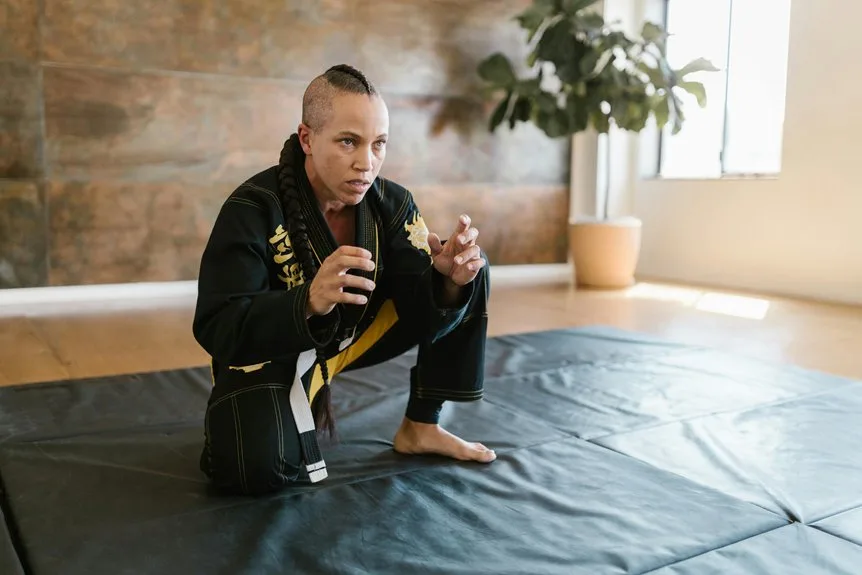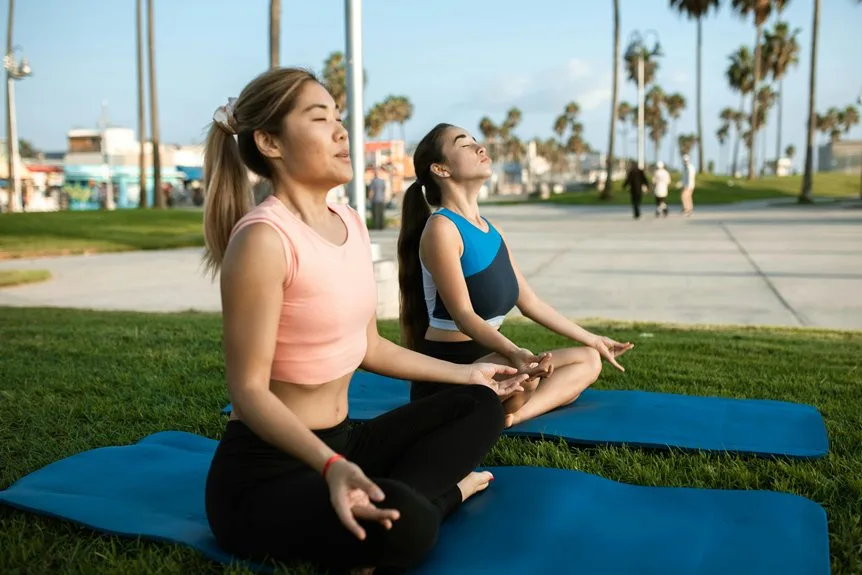When life gets overwhelming, mindfulness offers a toolkit for staying steady. Simple practices like deep breathing or paying close attention to the present moment can help people notice their feelings before reacting, almost like pressing pause during a tense movie scene. These techniques aren’t magic, but with practice, they can train the mind to bounce back from stress more quickly. Curious how this works and why it matters for everyday challenges?
Understanding Emotional Resilience
How does someone bounce back after facing a tough day or a challenging situation? Emotional resilience is what helps people recover and move forward. It’s like having an invisible shield, built from skills such as emotional regulation, keeping a positive outlook, and adapting to whatever life throws their way. People with strong emotional resilience tend to feel less anxiety and depression, making them better equipped to handle setbacks. Building emotional resilience isn’t just something you’re born with—it’s a skill you can grow. For example, visiting places like Cuyama Buckhorn with amenities such as a pool, jacuzzi, and barrel sauna with sunset views can provide a peaceful environment conducive to enhancing emotional resilience.
The Role of Mindfulness in Building Strength
Mindfulness brings people into the present moment, helping them notice what’s happening inside and around them without getting swept away by stress. This simple shift in attention can make a big difference, as it gives individuals the space to pause and choose how to respond, rather than reacting on autopilot. For those seeking tranquility and relaxation, places like Solage, Auberge Resorts Collection offer an ideal environment to practice mindfulness while immersing in wine and wellness experiences.
Present-Moment Awareness Benefits
A simple shift in attention—focusing on what’s happening right now—can work wonders for emotional strength. Practicing mindfulness in daily life, like using a Body scan or deep breathing, helps build resilience by allowing people to bounce back from adverse moments. Meditation and mindfulness practices, such as loving-kindness meditation or guided imagery, encourage paying attention to the present moment without judgment. These tools amplify mental health, reduce stress, and support emotion regulation, making it easier to handle challenges. Over time, mindfulness builds a sense of belonging and stability, helping individuals bounce back with greater ease. At Sensei Porcupine Creek, individuals can experience personalized wellbeing journeys guided by trained professionals, enhancing their ability to maintain emotional resilience. – Reduces rumination and stress – Enhances decision-making abilities – Amplifies emotional stability – Encourages healthier thought patterns – Improves overall mental health
Enhancing Self-Regulation Skills
One of the most impressive benefits of mindfulness is its power to strengthen self-regulation, that inner ability to keep emotions and impulses in check even when life throws curveballs.
By enhancing activity in the prefrontal cortex, mindfulness practices sharpen emotional control and help people handle stress without losing their cool.
Regular meditation quiets the amygdala, so reactions to stressors become calmer.
Present-moment awareness lets individuals spot emotional shifts before they boil over, making it easier to choose thoughtful responses.
Over time, mindfulness-based training leads to real improvements in self-regulation skills, building emotional resilience and a sense of shared strength.
Incorporating wellness and balance as a lifestyle, such as the practices offered at Two Bunch Palms, further enhances emotional resilience by providing a holistic approach to mindfulness and self-care.
Exploring Different Types of Resilience
Resilience isn’t just about bouncing back after tough times—it’s actually a blend of several different strengths that help people handle life’s curveballs.
By using the Resilience Scale, researchers have found that resilience has many layers, each bringing something unique. It’s not just about staying strong alone; it’s also about leaning on others and learning from life’s twists.
Here’s a snapshot of the main types:
- Physical resilience: Staying healthy and recovering from illness or exhaustion.
- Emotional resilience: Managing feelings during stress.
- Mental resilience: Adapting and learning from challenges.
- Social resilience: Relying on community.
- Mindfulness-enhanced resilience: Elevating all domains.
Present-Moment Awareness as a Foundation
Present-moment awareness means tuning in to what’s happening right now, without judging thoughts or feelings as good or bad.
By focusing on the here and now, people can let go of worries about the past or future, making space for a calmer, steadier mind.
This simple shift in attention serves as the foundation for mindfulness, offering a helpful reset button when life gets overwhelming.
Embracing Here and Now
Ever wondered why people talk so much about “living in the moment”? Embracing the here and now means tuning into what’s happening right now—like feeling your feet on the ground or tasting your lunch with mindful eating.
This kind of present-moment awareness isn’t just trendy; it actually helps the brain handle stress and bounce back from tough situations. People who practice staying present often notice they feel less overwhelmed and more connected to others.
Ways to anchor attention include:
- Focusing on breath sensations
- Trying mindful eating at meals
- Doing a quick body scan
- Noticing sounds around you
- Observing your surroundings
Nonjudgmental Present Focus
A key ingredient in mindfulness is learning to focus on the present moment without passing judgment on whatever pops up. This means noticing thoughts and feelings—like stress or doubt—without labeling them as “bad” or “good.”
Whether practicing mindful eating or simply paying attention to your breath, this nonjudgmental present focus helps people accept what’s happening right now. Science shows that it can actually reshape the brain, making it easier to handle tough emotions.
Flexibility and Adaptability Through Mindfulness
Life has a habit of throwing curveballs when least expected, and while some people seem to roll with the punches, others find change a bit more overwhelming.
Mindfulness can make a big difference here, helping people manage stress and stay grounded when routines get shaken up. By teaching nonjudgmental awareness, mindfulness encourages flexibility, making it easier to spot old habits and try new approaches.
It’s like having a mental toolkit for tough times. Consider these benefits of mindfulness for adaptability:
- Recognizes automatic reactions
- Encourages open-mindedness
- Supports Stress Management
- Boosts brain regions for flexibility
- Nurtures calm responses to change
Embracing Uncertainty With Mindful Practices
Uncertainty has a way of showing up just when things seem to be settling down, much like an unexpected guest at the dinner table. By practicing mindfulness, people can welcome this guest with less anxiety.
Mindful breathing and body scans soothe the nerves, helping the mind respond with curiosity instead of panic. The daily habit of present-focused awareness enhances uncertainty tolerance, making it easier to go with life’s unpredictable flow.
Mindfulness meditation also strengthens the brain’s ability to adapt, while noticing fleeting thoughts teaches that discomfort isn’t permanent. Together, these practices create a sense of connection and shared resilience.
Cultivating Self-Knowledge and Self-Control
Mindfulness helps people notice their feelings as they arise, making it easier to spot patterns and manage emotions before they take over.
By paying attention to the present moment, individuals can pause before reacting impulsively and instead choose more thoughtful responses.
Over time, these habits build up, creating a kind of mental muscle that supports better choices and steadier moods, even when life throws a curveball.
Enhancing Emotional Awareness
Ever wondered how some people seem to keep their cool, even when emotions run high? The secret often lies in enhancing emotional awareness. Mindfulness, paired with techniques like Color Therapy, helps individuals notice their feelings early, before emotions spiral.
By observing thoughts and bodily sensations, people begin to recognize what triggers them. This leads to greater self-knowledge and self-control, making it easier to respond thoughtfully rather than react impulsively.
Here are some ways to amplify emotional awareness:
- Practice daily mindfulness meditation
- Use Color Therapy to identify mood shifts
- Keep an emotion journal
- Check in with body sensations
- Reflect before responding
Managing Impulsive Reactions
In the middle of a heated moment, it’s easy to say or do something that’s later regretted. Mindfulness helps people notice those impulsive urges before they take over.
By practicing techniques like body scans or mindful breathing, individuals create a small, but powerful, pause between feeling and reacting. This pause strengthens the prefrontal cortex, the part of the brain that supports impulse control and better choices.
Regular mindfulness also quiets the amygdala, so emotional reactivity is dialed down. With growing self-knowledge, people become more aware of what triggers them, leading to more thoughtful responses and a greater sense of belonging.
Building Adaptive Habits
How does someone actually stick to healthier habits when old patterns seem so stubborn? Mindfulness helps people notice their emotional triggers and gently pause before reacting, making positive change possible. By paying attention to what’s really happening inside, they can identify strengths, spot challenges, and build routines that actually fit their lives—like improving sleep hygiene or taking mindful breaks.
These small, intentional shifts can add up, helping everyone feel more connected and in control. A few ways to build adaptive habits:
- Practice daily body scans
- Reflect mindfully on experiences
- Set gentle prompts
- Prioritize sleep hygiene
- Celebrate small victories
Moving Beyond the Fix-It Mentality
Why does it sometimes feel like life is just a never-ending list of things to fix? This “Problem Fixation” can lead to burnout, making everyday moments heavy and exhausting.
Moving beyond the fix-it mentality means shifting attention to what’s already good—those small wins, simple joys, and strengths that often go unnoticed. By practicing gratitude and recognizing what’s working well, people build resilience and a sense of belonging.
It’s about seeing happiness as a process, not a project. Focusing on well-being, instead of just fixing issues, helps create a more balanced, sustainable mindset that supports emotional growth and deeper connections.
Positive Psychology and Its Connection to Resilience
Ever notice how some people seem to bounce back from tough times with surprising strength? Positive psychology highlights the importance of a Strengths Focus, showing that nurturing what’s going well builds emotional resilience.
Instead of just fixing problems, it encourages savoring life’s small joys and expressing gratitude. Research suggests that this approach, championed by experts like Seligman and Fredrickson, helps people recover and stay connected during challenges.
Belonging and optimism grow when strengths are celebrated. Some key positive psychology strategies include:
- Practicing gratitude daily
- Savoring positive moments
- Identifying personal strengths
- Expressing kindness
- Cultivating optimism
Essential Mindfulness Techniques for Everyday Life
A growing number of people are uncovering that mindfulness isn’t just reserved for yoga studios or silent retreats—it’s a practical tool that fits right into daily life. Simple methods like mindful eating, where one fully notices flavors, textures, and sensations, help anchor attention in the present.
Body scan meditations and deep breathing calm nerves, while even a short ten-minute session can make emotions easier to handle. Walking mindfully or using the 5-4-3-2-1 grounding technique can steady a busy mind.
Adding compassion meditation to routines supports a sense of connection, making resilience feel like something everyone can share.
Building a Positive Mindset With Daily Habits
Building a positive mindset isn’t about ignoring life’s challenges—it’s about weaving small, meaningful habits into each day that gently shift outlook. Daily actions, like jotting down gratitude lists or repeating positive affirmations, help cultivate emotional resilience and optimism.
When these habits are practiced in community or with loved ones, they build a sense of belonging and shared joy. Simple routines and mindful moments can make positivity feel natural, even during tough times.
Try adding these uplifting habits:
- Write a gratitude list each morning
- Practice positive affirmations aloud
- Perform a daily act of kindness
- Savor small, joyful experiences
- Pause for mindful check-ins
Resources and Tools for Ongoing Practice
When it comes to keeping mindfulness habits alive, having the right resources and tools can make all the difference. Guided meditations from sites like The Free Mindfulness Project or Rick Hanson’s page are easy to access and help keep practice fresh.
Online courses, such as James Baraz’s Awakening Joy, offer structure and a sense of shared progress.
Mobile apps like Headspace and Calm bring mindfulness recipes—like breathing exercises and body scans—straight to your phone.
The Greater Good Science Center shares articles, quizzes, and practical tips, helping everyone feel connected and supported on their resilience expedition, even on the busiest days.
Professional Support for Mindful Resilience
While apps and online resources can keep mindfulness practice interesting, many people find that having a professional in their corner brings a whole new level of support.
Therapeutic Guidance from licensed therapists or coaches helps individuals create mindfulness routines that fit their unique needs. Professionals teach techniques like body scans, guided meditations, and breathing exercises, making sure each practice is safe and effective.
This kind of support helps build habits that stick, while also enhancing emotional resilience in the long run.
- Personalized mindfulness plans
- Evidence-based strategies
- Consistent practice with accountability
- Safe, supportive environment
- Long-term emotional well-being
Frequently Asked Questions
How Does Mindfulness Build Emotional Resilience?
Mindfulness builds emotional resilience by enhancing awareness of emotional states and promoting stress reduction. Individuals experience increased self-regulation and calmness, nurturing a sense of connection and belonging, which supports recovery from setbacks and encourages adaptive responses to challenges.
How to Strengthen Your Emotional Resilience?
Like a tree weathering a storm, individuals can strengthen emotional resilience through effective stress management, nurturing supportive connections, and embracing healthy routines—allowing them to stand tall together, even as life’s winds try to uproot them.
What Are the 3 P’s of Emotional Resilience?
The 3 P’s of emotional resilience—Perception, Purpose, and Practice—guide individuals toward personal growth. By reframing challenges, finding meaning, and consistently applying positive habits, people can cultivate connection, reduce stress, and enhance their sense of belonging.
What Are the 7 C’s to Build Resilience?
Like knights gathering for a quest, individuals build resilience through the 7 C’s: Control, Courageous Commitment, Challenge, Confidence, Connection, Coping, and Character, each forming a shield that promotes collective strength and a sense of belonging.
Final Thoughts
Like Odysseus steering stormy seas, anyone can chart a steady course through life’s ups and downs with mindfulness as their compass. These simple practices—body scans, deep breaths, and mindful observation—offer anchor points when emotions run high. Over time, they help build emotional muscle, making challenges less daunting and victories sweeter. With a little patience and practice, resilience becomes less a rare treasure and more a reliable ally, ready to face whatever tides may come.







